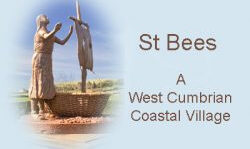Parish Council History - Preface
Preface by John Todd
“As One Door Closes, Another Opens.”
1895 was the first year of St. Bees Parish Council. It was also the last of the St. Bees Theological College. Started in 1816, the College was the first institution outside the universities of Oxford and Cambridge for training Church of England clergy. For many villages, the closure of the College would have been regarded as a catastrophe. It meant loss of employment for the Tutor and the Lecturer, and the loss of the spending power of up to ninety students, all of whom lodged in and around the village.
Yet both church and village seem to have taken the event in their stride. True, they petitioned the Bishop against the closure. But three years later, a visitor to the village had difficulty in finding anyone who could direct him to where the College had been! The church, under a new vicar, Mr. Alexander, was laying plans for the building of a magnificent new organ, of cathedral proportions, completed in 1899 by the famous “Father” Henry Willis. Meanwhile, St. Bees School, founded in 1583, but transformed in 1844 from a small rural grammar school to an independent boarding school, was growing in numbers and buildings. The boarding capacity of the school had been greatly increased with the construction of “School” House in 1886: the swimming baths followed in 1898, the gymnasium in 1899, the chapel in 1907 and a new teaching block in 1910.
Tourists, brought to the village by the new railway in 1850, were on the increase, as the working classes gained the spending power to take holidays by the sea. The railway also brought commuters from Whitehaven and Workington to the cleaner air of St. Bees, and the turn of the century saw the building of the last new houses in the Main Street until after the Second World War.
More boys to the School, students to the College, tourists to the beach and commuters to the villas of the Main Street and High House Road: these had been the growing points of the second half of the nineteenth century. These factors helped to put the village on the national map and to some extent marked it off from other rural Cumbrian villages.
St. Bees was conscious also of the depth of its history. The church was far larger than the population of the village needed, because it had served the Benedictine priory which had been the focus of the village from before 1135 to 1539. The priory itself was the successor of another church on the same site, certainly existing in the tenth century, and – in legend at any rate – taking its origin in the hermitage of an Irish virgin, Bega, centuries before that. It is indeed probable that St. Bees was a minster in the seventh or eighth centuries, the first and leading church of a territory stretching from Workington almost to Millom. After 1539, when the priory was dissolved, the parish courageously took on the responsibility for maintaining all but the easternmost part of the building as the parish church.
Until the nineteenth century, the livelihood of the inhabitants of St. Bees came almost entirely from the land or the sea. North-west of the Pow Beck, the farms were occupied by tenants of the Lowther family, all-powerful landlords in West Cumbria. But south-east of the Beck, after 1609, the farmers held their land as tenants of the School under thousand-year leases at low, fixed rents. This gave them considerable independence, and St. Bees has none of the uniform appearance of those villages which were dominated by the interests and requirements of the “Big House”. The results of independence can be seen in the eighteenth-century rebuilding of many of the farmhouses that lined the west side of the Main Street; it may also survive in a cast of mind that bows to no higher authority. Gradually, as the prosperity of Whitehaven increased on the profits of traffic in coal and iron ore, the economies of St. Bees and its large neighbour four miles to the north intermingled. St. Bees was joined to Whitehaven by a turnpike road soon after 1739. The number of farms dwindled through amalgamation, and as the nineteenth century went on more and more people found work in the mines and quarries, the town, the School, and the services of a varied village community.
It is at this point, close to a crest in the prosperity of St. Bees, that the history of the Parish Council opens, and with it a new chapter in the history of the whole village.
John M Todd
—————
Copyright D T Sim 1995 and 2004, adapted for web viewing by the author in 2004.
Adapted from the booklet “100 years of St. Bees”, published in 1995 by St. Bees Parish Council, to celebrate 100 years of parish councils.
